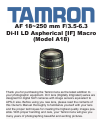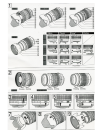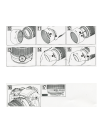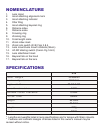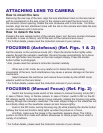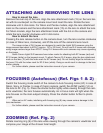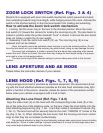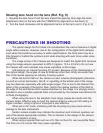
Stowing lens hood on the lens (Ref. Fig. 9)
1. Reverse the lens hood. Point the lens toward the opening, then align the hood
attachment mark on the lens with the (TAMRON O) alignment on the hood (3).
2. Turn the hood clockwise until its alignment mark is at the top to set it. (Fig. 9, 2)
PRECAUTIONS IN SHOOTING
The optical design for Di-II takes into consideration the various features of digital
single reflex cameras. However, due to the configuration of the digital SLR cameras,
even when the Autofocus accuracy is within specifications, the focal point may be a
little forward or behind the optimum point when shooting with auto focus under some
conditions.
The image circles of Di-II lenses are designed to match the digital SLR cameras
using the image sensors equivalent to APS-C (approx. 15.5 x 23.2mm). Do not use
Di-II lenses with such cameras may cause vignetting on the image.
A18 employs an internal focusing (IF) system. Because of the characteristics of
this optical design, the angles of view at distances other than infinity are wider than
that of the lenses applying an ordinary focusing system.
When the built-in flash on the camera is used, adverse photographic phenome-
na such as corner illumination, fall-off, or vignetting at the bottom part of the image
may be observed, especially with wide angle ranges. This is due to the inherent limi-
tation of the coverage of the built-in flash, and/or the relative position of the flash to
the edge of the lens barrel which causes shadows on the image. It is strongly recom-
mended to use a suitable separate flash unit provided by the camera manufacturer for
all flash photography.
When using the lens in the telephoto focal range, please be careful with the
camera shake. Effective way to avoid the camera shake is using an ISO setting of
higher numbers. Using a tripod or monopod is also effective.
When set on AF mode, interfering with the focusing ring may cause serious
damage to the lens mechanism.
Certain camera models may indicate the maximum and minimum aperture val-
ues of the lenses appropriate numbers. This is inherent to the design of the camera
and not an indication of error.
When using a special filter such as a PL filter on the A18, use low-profile filters.
The thick rim of a normal filter may cause vignetting.



